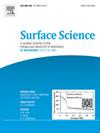SF6分解气体的吸附与传感;Fe和Co修饰单层BC6N上的SO2、SO2F2、SOF2、H2S和HF。采用基于研究
IF 1.8
4区 化学
Q3 CHEMISTRY, PHYSICAL
引用次数: 0
摘要
SF6断路器的局部放电将SF6分解为低氟气体,与微量水分反应形成腐蚀性酸,使触点退化,降低灭弧能力,需要全天候监测系统进行早期发现和预防。本文通过DFT计算,研究了硼氮化碳(BC6N)单层在SF6分解气体SO2、SO2F2、SOF2、H2S和HF中的潜在应用。通过吸附能、电荷密度差、态密度来评价吸附性能,通过能带结构、功函数、输运传输和恢复时间计算来评价灵敏度。结果表明,原始BC6N对气体分子的吸附能力较弱,而经Fe和Co修饰的BC6N对气体分子的吸附能分别为-1.01 ~ -1.61 eV和-0.95 ~ -1.58 eV。扩散能垒计算证实了Fe和Co原子不会形成团簇。Fe/BC6N和Co/BC6N对气体分子的敏感性分别为:SO2F2>为67.5%和72.9%;(70.8%和65%);(68.7%和62.5%);(64.5%和57.5%);(58.3%和50%)。恢复时间计算结果表明,吸附最强的SO2F2分子在498 K温度下的解吸时间为117.5 h,而在紫外线照射下的解吸时间大大缩短至1.69纳秒。我们提出的底物可以主动吸附、传感和瞬间解吸目标气体分子,证明Fe/BC6N和Co/BC6N有潜力成为高灵敏度和可重复使用的气体传感器。本文章由计算机程序翻译,如有差异,请以英文原文为准。

Adsorption and sensing SF6 decomposed gases; SO2, SO2F2, SOF2, H2S, and HF on Fe and Co decorated monolayer BC6N. First-principles study
Partial discharges in SF6 circuit breakers decompose SF6 into low-fluorine gases, which react with trace moisture to form corrosive acids, degrading contacts and impairing arc quenching capacity, necessitating a 24/7 monitoring system for early detection and prevention. In this work, carbon boronitride (BC6N) monolayer is investigated for potential application of SF6 decomposed gases SO2, SO2F2, SOF2, H2S, and HF through DFT calculations. Adsorption performance through adsorption energy, charge density difference, density of states, while sensitivity through band structures, work function and transport transmission and recovery through recovery time calculations are evaluated. Results show that pristine BC6N is weakly absorbing the gas molecules, however, BC6N decorated with Fe and Co atoms chemisorbs the gas molecules with enhanced adsorption energy -1.01 to -1.61 eV and -0.95 to -1.58 eV respectively. Diffusion energy barrier calculation confirms that Fe and Co atoms don’t make clusters. Sensitivity of Fe/BC6N and Co/BC6N to gas molecules respectively follows: (67.5 % and 72.9 %) for SO2F2> (70.8 % and 65 %) for SOF2> (68.7 % and 62.5 %) for SO2> (64.5 % and 57.5 %) for H2S> (58.3 % and 50 %) for HF. Recovery time calculations results show that strongest adsorbed SO2F2 molecule takes 117.5 h to be desorbed at 498 K temperature, which is considerably shortened to 1.69 nanoseconds upon UV exposure. Our proposed substrates can actively adsorb, sense and instantaneously desorb the target gas molecules, proving that Fe/BC6N and Co/BC6N can potentially be highly sensitive and reusable gas sensors.
求助全文
通过发布文献求助,成功后即可免费获取论文全文。
去求助
来源期刊

Surface Science
化学-物理:凝聚态物理
CiteScore
3.30
自引率
5.30%
发文量
137
审稿时长
25 days
期刊介绍:
Surface Science is devoted to elucidating the fundamental aspects of chemistry and physics occurring at a wide range of surfaces and interfaces and to disseminating this knowledge fast. The journal welcomes a broad spectrum of topics, including but not limited to:
• model systems (e.g. in Ultra High Vacuum) under well-controlled reactive conditions
• nanoscale science and engineering, including manipulation of matter at the atomic/molecular scale and assembly phenomena
• reactivity of surfaces as related to various applied areas including heterogeneous catalysis, chemistry at electrified interfaces, and semiconductors functionalization
• phenomena at interfaces relevant to energy storage and conversion, and fuels production and utilization
• surface reactivity for environmental protection and pollution remediation
• interactions at surfaces of soft matter, including polymers and biomaterials.
Both experimental and theoretical work, including modeling, is within the scope of the journal. Work published in Surface Science reaches a wide readership, from chemistry and physics to biology and materials science and engineering, providing an excellent forum for cross-fertilization of ideas and broad dissemination of scientific discoveries.
 求助内容:
求助内容: 应助结果提醒方式:
应助结果提醒方式:


